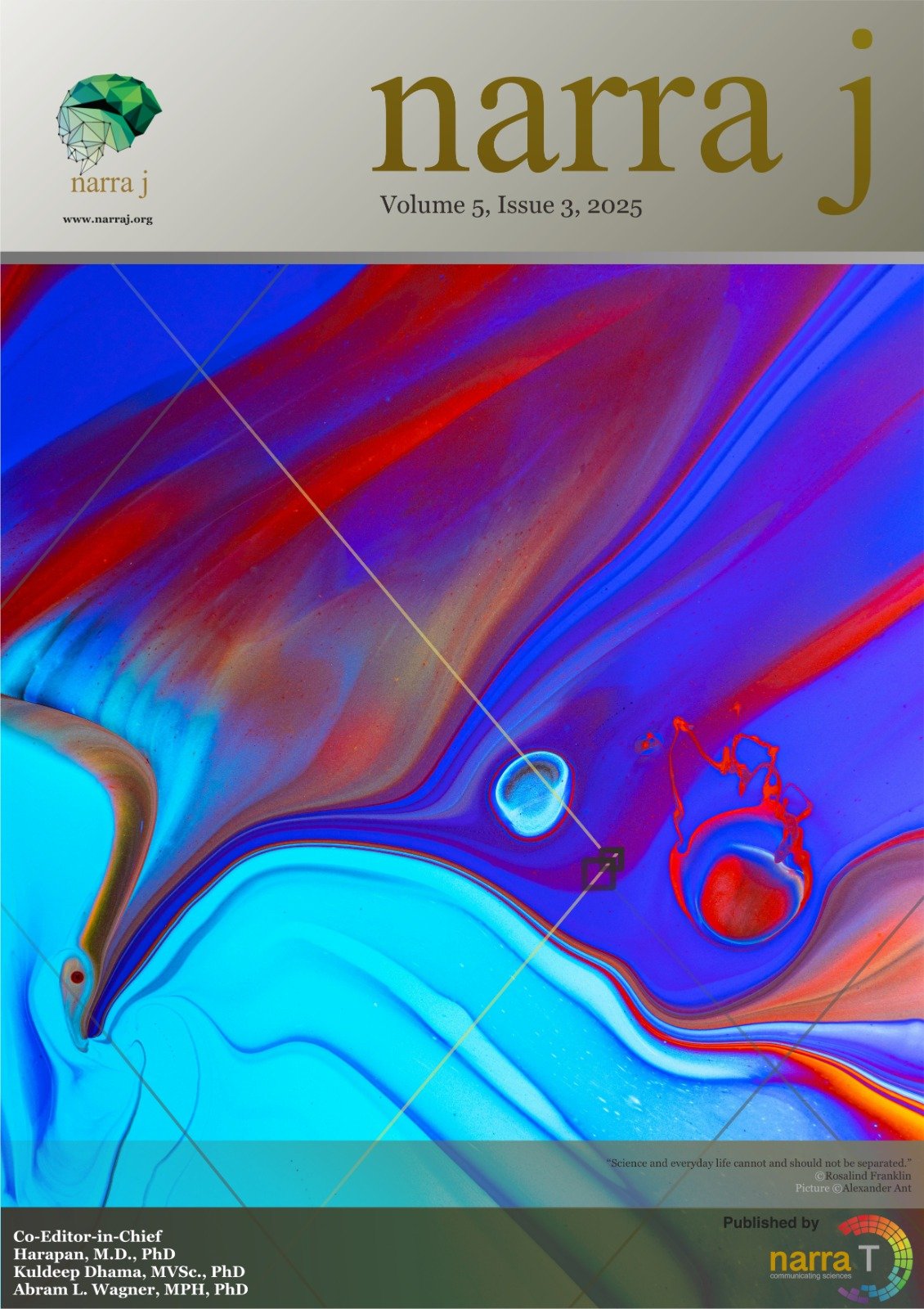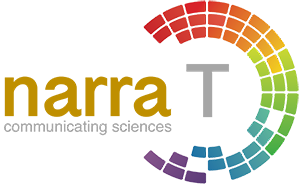Biopsychosocial determinants of anxiety and depression among working mothers in China: A public mental health perspective
DOI:
https://doi.org/10.52225/narra.v5i3.2754Keywords:
Mental health, anxiety symptoms, depressive symptoms, working mothers, factorsAbstract
Working mothers often face dual demands from work and parenting, increasing their risk for anxiety and depression. However, the prevalence and contributing factors among Chinese working mothers remain underexplored. The aim of this study was to examine the prevalence and biopsychosocial determinants of anxiety and depression in this population. A cross-sectional survey was conducted between October 17 and November 21, 2024 through WeChat online among 330 working mothers aged 30–45 years old using validated instruments, including the Outcome Inventory-21 (OI-21), Parental Stress Scale (PSS), Experiences in Close Relationships-revised (ECR-R-10), Inner Strength-based Inventory (I-SBI), and the Multidimensional Scale of Perceived Social Support (MSPSS). Sociodemographic, socioeconomic and biological factors, including age, marital status, annual income, and physical disease, were also collected through a self-administered general information questionnaire. Data were analyzed using t-test, analysis of variance, Pearson’s correlation, and hierarchical linear regression. This study found the prevalence was 26.1% for anxiety symptoms and 38.2% for depression symptoms in this group based on the screening tools. Anxiety was significantly associated with both biological (e.g., hormonal changes, family psychiatric history) and psychological factors (e.g., attachment anxiety, parental stress). At the same time, depressive symptoms were primarily predicted by psychological and lifestyle-related factors (e.g., smoking, alcohol use). Notably, inner strength was a protective factor across both conditions. The findings highlight the importance of early detection and integrative care strategies for addressing mental health concerns in working mothers. Incorporating psychological screening, lifestyle assessment, and resilience-building interventions into workplace and community-based healthcare services may improve work-family balance outcomes in this population.
Downloads
References
References
COVID-19 Mental Disorders Collaborators. Global prevalence and burden of depressive and anxiety disorders in 204 countries and territories in 2020 due to the COVID-19 pandemic. Lancet (London) 2021;398(10312):1700–1712.
GBD 2019 Mental Disorders Collaborators. Global, regional, and national burden of 12 mental disorders in 204 countries and territories, 1990-2019: A systematic analysis for the Global Burden of Disease Study 2019. Lancet Psychiatry 2022;9(2):137–150
Liu Q, He H, Yang J, et al. Changes in the global burden of depression from 1990 to 2017: Findings from the Global Burden of Disease study. J Psychiatr Res 2020;126:134–140.
Arias D, Saxena S, Verguet S. Quantifying the global burden of mental disorders and their economic value. EclinicalMedicine 2022;54:101675.
World Health Organization. Mental Health in China. Available online: https://www.who.int/china/health-topics/mental-health (accessed on 10 March 2025).
Lin W, Wang H, Gong L, et al. Work stress, family stress, and suicide ideation: A cross-sectional survey among working women in Shenzhen, China. J Affect Disord 2020;277:747–754.
Raymo JM, Park H, Xie Y, et al. Marriage and Family in East Asia: Continuity and Change. Annu Rev Sociol 2015;41:471–92.
Guo X, Zhong S, Li L, et al. How housing burden damages residents’ health: Evidence from Chinese cities. Frontiers in Public Health 2024;12:1345775.
Textor C. Population in China from 2014 to 2024, by gender. Statista. Available online: https://www.statista.com/statistics/1225146/china-employment-situation-of-mothers/ (accessed on 17 January 2025).
Chen G, Oubibi M, Liang A, et al. Parents' Educational Anxiety Under the "Double Reduction" Policy Based on the Family and Students' Personal Factors. Psychol Res Behav Manag 2022;15:2067–2082.
Sun J, Liu T, Gao Y, et al. Questionnaire development on measuring parents' anxiety about their children's education: Empirical evidence of parental perceived anxiety data for primary and secondary school students in China. Front Psychol 2022;13, 1018313.
Chai H, Fu R, Coyte PC. How Do Middle-Aged Chinese Men and Women Balance Caregiving and Employment Income? Healthcare 2021;9(4):415.
He L, Mai Z, Guan X, et al. The Moderating Role of Social Capital Between Parenting Stress and Mental Health and Well-Being Among Working Mothers in China. Healthcare 2025;2(1):117.
Engel GL. The need for a new medical model: A challenge for biomedicine. Science 1977;196(4286):129–36.
Wade DT, Halligan PW. The Biopsychosocial model of illness: a model whose time has come. Clin Rehabil 2017;31(8):995–1004.
Chan CY, Lee AM, Koh YW, et al. Associations of body dissatisfaction with anxiety and depression in the pregnancy and postpartum periods: a longitudinal study. J Affect Disord 2020;263: 582–92.
Jalali A, Ziapour A, Karimi Z, et al. Global prevalence of depression, anxiety, and stress in the elderly population: a systematic review and meta-analysis. BMC geriatrics 2024;24:809.
Zhang Y, Hu TT, Cheng YR, et al. Global, regional, and national burden of anxiety disorders during the perimenopause (1990-2021) and projections to 2035. BMC women's health 2025;25:11.
Ochoa-Fuentes DA, Gutiérrez-Chablé LE, Méndez-Martínez S, et al. Confinement and social distancing: stress, anxiety, depression in children and adolescents. Rev Med Inst Mex Seguro Soc 2022;60:338–344.
Meda RT, Nuguru SP, Rachakonda S, et al. Chronic Pain-Induced Depression: A Review of Prevalence and Management. Cureus 2022;14(8):e28416.
Boson K, Anderberg M, Wenneberg P, et al. Long-Term Outcomes of Adolescent Outpatient Treatment for Substance Use Problems: Exploring the Co-occurrence of Mental Health and Substance Use Problems. Scand J Child Adolesc Psychiatr Psychol 2024;12:20240013.
Sandnes R, Le Floch M, Riquin E, et al. Parental stress and mental health outcomes following very preterm birth: A systematic review of recent findings. J Affect Disord 2024;355:513–525.
Nan Y, Xie Y, Hu, Y. Internet use and depression among Chinese older adults: The mediating effect of interpersonal relationship. Front Public Health 2023;11:1102773.
Thongprem T, Deechaiya R, Chanachai S, et al. Moderating Effect of Variables Associated with Positive Mental Health in a Mediation Model on Depression among College Students: Protocol for a Longitudinal Study. Healthcare 2023;11(13):1709.
Bowlby J. Attachment and Loss. Vol. I. Attachment. Man 1969;5:523.
Simpson JA, Rholes WS. Adult attachment, stress, and romantic relationships. Curr Opin Psychol 2017;13:19–24.
Shao R, He P, Ling B, et al. Prevalence of depression and anxiety and correlations between depression, anxiety, family functioning, social support and coping styles among Chinese medical students. BMC psychology 2020;8:38.
Demir UF, Bozkurt O. Evaluation of anxiety, depression and marital relationships in patients with migraine. Ideggyogyaszati szemle 2020;73(3-4):129–134.
Qian G, Mei J, Tian L, et al. Assessing mothers' parenting stress: differences between one- and two-child families in China. Front Psychol 2021;11:609715.
Kist Bakof K, Morais Machado L, Rocha Iensen G, et al. Stress and its contribution to the development of depression symptoms are reduced in caregivers of elderly with higher educational level. Stress 2021;24(6):676–685.
Ma X. Impact of long working hours on mental health: evidence from China. Int J Environ Res Public Health 2023;20:1641.
Qian Z, Pines A, Stone BV, et al. Changes in anxiety and depression in patients with different income levels through the COVID-19 pandemic. J Affect Disord 2023;338:17–20.
Wongpakaran N, Wongpakaran T, Kövi Z. Development and validation of 21-item outcome inventory (OI-21). Heliyon 2022;8(12):e09682.
Wang X, Wongpakaran T, Pojanapotha P, et al. Anxiety and Associated Factors Among Chinese Preschool Teachers. Educ. Sci 2024;14(10):1242.
Berry JO, Jones WH. The parental stress scale: initial psychometric evidence. J Soc Pers Relat 1995;12(3):463–72.
Cheung SK. Psychometric properties of the Chinese version of the parental stress scale. Psychologia 2000;43(4):253–261.
Wongpakaran T, Yang T, Varnado P, et al. The development and validation of a new resilience inventory based on inner strength. Sci Rep 2023;13:2506.
Mao B, Kanjanarat P, Wongpakaran T, et al. Factors Associated with Depression, Anxiety and Somatic Symptoms Among International Salespeople in the Medical Device Industry: A Cross-sectional Study in China. Healthcare 2023;11(9):2174.
Fraley RC, Waller NG, Brennan KA. An item response theory analysis of self-report measures of adult attachment. J Pers Soc Psychol 2000;78(2):350–365.
Wongpakaran N, Wongpakaran T, Lerttrakarnnon P, et al. Psychometric assessment of the 10-item, revised experience of close relationship (ECR-R-10) in nonclinical and clinical populations of adults and older adults in Thailand. Sci Rep 2023;13:14969.
Li T, Kato K. Measuring adult attachment: Chinese adaptation of the ECR scale. Acta Psychol. Sin 2006;38(3):399–406.
Zimet GD, Dahlem NW, Zimet SG, et al. The multidimensional scale of perceived social support. J. Pers. Assess 1988;52(1):30–41.
Wang Y, Wan Q, Huang Z, et al. Psychometric properties of multi-dimensional scale of perceived social support in Chinese parents of children with cerebral palsy. Front Psychol 2017;8:2020.
Wang X, Zhao G, Di J, et al. Prevalence and risk factors for depressive and anxiety symptoms in middle-aged Chinese women: a community-based cross-sectional study. BMC women's health 2022;22:319.
Khan MF, Shahzadi S. Understanding Parenting and Pregnant Women’s Perceptions of Accessing, Utilizing, and Barriers to Seeking Social Support for Mental Well-Being. Behavioral Sciences 2023;15(3):348.
Jin L, Pan C, Zhao C, et al. Perceived social support and symptoms of depression and anxiety among Chinese adolescents: A moderated chain mediation model. International Journal of Mental Health Promotion 2025;27(1):29–40.
Kim H Y, Hong Y C, Lee N, et al. Working From Home, Work-Life Balance, and Depression/Anxiety Among Korean Workers in the COVID-19 Pandemic Period: A Mediation Analysis. J Occup Environ Med 2023;65:98–103.
Zhang N, Gao X, Li D, et al. Sleep deprivation-induced anxiety-like behaviors are associated with alterations in the gut microbiota and metabolites. Microbiol Spectr 2024;12:e0143723.
Modak A, Ronghe V, Gomase KP, et al. A Comprehensive Review of Motherhood and Mental Health: Postpartum Mood Disorders in Focus. Cureus 2023;15:e46209.
Li B, Allebeck P, Burstöm B, et al. Educational level and the risk of mental disorders, substance use disorders and self-harm in different age-groups: A cohort study covering 1,6 million subjects in the Stockholm region. Int J Methods Psychiatr Res 2023;32:e1964.
Chow MSC, Poon SHL, Lui KL, et al. Alcohol Consumption and Depression Among University Students and Their Perception of Alcohol Use. East Asian Arch Psychiatry 2021;31:87–96.
Aarntzen L, Derks B, van Steenbergen E, et al. When work–family guilt becomes a women's issue: Internalized gender stereotypes predict high guilt in working mothers but low guilt in working fathers. British Journal of Social Psychology 2023;62(1):12–29.
Clark DA, Rock AJ, Coventry WL. Adult attachment, worry and reassurance seeking: Investigating the role of intolerance of uncertainty. Clinical Psychologist 2020;24(3):239–249.
Wasti SP, Simkhada P, van Teijlingen ER, et al. The Growing Importance of Mixed-Methods Research in Health. Nepal J Epidemiol 2022;12:1175-1178.
Downloads
How to Cite
Issue
Section
Citations
License
Copyright (c) 2025 Jia Jiao, Rewadee Jenraumjit, Shirley Worland , Saifon Bunyachatakul , Bijing He, Tinakon Wongpakaran

This work is licensed under a Creative Commons Attribution-NonCommercial 4.0 International License.



